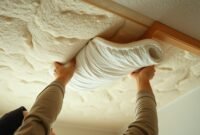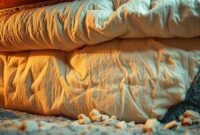Do you find your basement cold and drafty? It can really raise your energy bills. Many people struggle with poor insulation in their basements.
Choosing the right insulation for your basement ceiling is key. It affects your home’s comfort and how much energy it uses. I’ll help you understand your options, so you can pick the best one for your needs.
Learning about faced and unfaced insulation can help you find the perfect solution. It will make your basement a cozy, energy-saving part of your home.
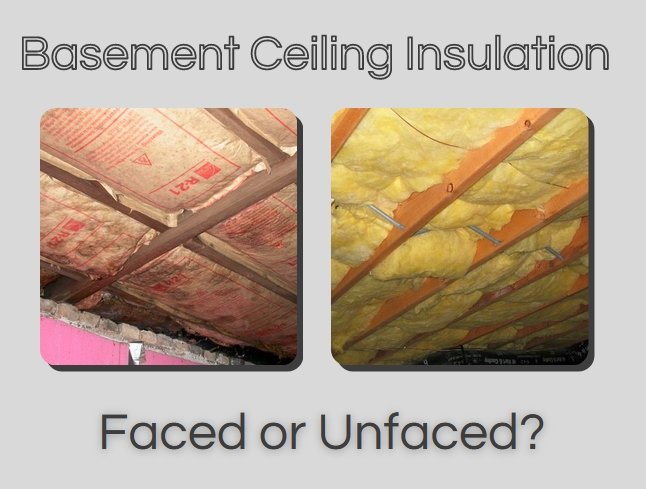
Understanding the Basics of Basement Insulation Types
Choosing the right insulation for your basement is key to saving energy and staying comfortable. Fiberglass batts are a top pick for many homeowners. They help keep your basement warm in winter and cool in summer.
Read also: Does Attic Insulation Help in Summer
I’ll explain the main differences between faced and unfaced insulation. This will help you decide what’s best for your basement renovation.
What Makes Faced Insulation Different
Kraft paper faced insulation batts have a special feature. The paper facing acts as a vapor barrier. This helps control moisture in basements. These batts usually include:
- A protective paper or plastic facing
- Integrated vapor retarder
- Enhanced moisture control properties
Key Components of Unfaced Insulation
Unfaced insulation is simpler. It doesn’t have a vapor barrier. Instead, it focuses on keeping your basement warm. It’s best when you don’t need extra moisture control.
Read also: What Is Unfaced Insulation?
Role of Vapor Barriers in Insulation
| Insulation Type | Vapor Barrier | Moisture Control |
|---|---|---|
| Faced Insulation | Integrated | High |
| Unfaced Insulation | Separate installation required | Moderate |
Vapor barriers are vital in basement insulation. They stop moisture buildup, prevent mold, and keep your basement structure strong.
The Science Behind Vapor Retardation in Basement Ceilings
To control moisture in basement ceilings, we need to understand how water vapor moves. Thermal insulation is key to stop damage from moisture and condensation.
Vapor retardation is a complex process that keeps your basement dry. Let’s explore the science behind it. It’s vital for a healthy basement.
- Moisture travels through materials via diffusion and air movement
- Basement spaces are vulnerable to humidity challenges
- Vapor retarders block moisture transmission through insulation layers
The main idea of vapor retardation is to create a barrier. This barrier stops water molecules from passing through insulation. It’s important for keeping your basement strong and mold-free.
| Vapor Transmission Mechanism | Potential Risks | Prevention Strategy |
|---|---|---|
| Diffusion | Insulation Degradation | Vapor Retarder Installation |
| Air Movement | Condensation Buildup | Proper Sealing |
| Temperature Differential | Mold Growth | Thermal Barrier Implementation |
By using the right moisture control, you can protect your basement ceilings. Knowing the science helps you make smart choices about insulation and vapor management.
Basement Ceiling Insulation Faced or Unfaced: Making the Right Choice
Choosing the right fiberglass insulation for your basement ceiling is important. It affects your home’s energy use and comfort.
When picking between faced and unfaced insulation, several things matter. Knowing these can help you choose the best option for your home.
Critical Decision Factors
- Existing moisture levels in your basement
- Local climate conditions
- Home’s current ventilation system
- Budget constraints
- Long-term energy efficiency goals
Climate Considerations
Your local climate is key in choosing insulation. Different areas need different solutions for humidity and temperature.
| Climate Zone | Recommended Insulation Type | Primary Concern |
|---|---|---|
| Cold Regions | Faced Insulation | Moisture Barrier |
| Humid Regions | Unfaced Insulation | Breathability |
| Moderate Climates | Hybrid Approach | Flexible Solution |
Installation Requirements
Installing faced and unfaced insulation is different. Faced needs careful vapor barrier setup, while unfaced is more flexible.
- Measure basement ceiling dimensions accurately
- Check local building codes
- Assess existing moisture control mechanisms
- Select appropriate insulation type
- Prepare proper installation tools
It’s wise to talk to a pro for the best insulation choice. Each home is unique, and experts can guide you to better energy use.
Benefits and Drawbacks of Faced Fiberglass Insulation
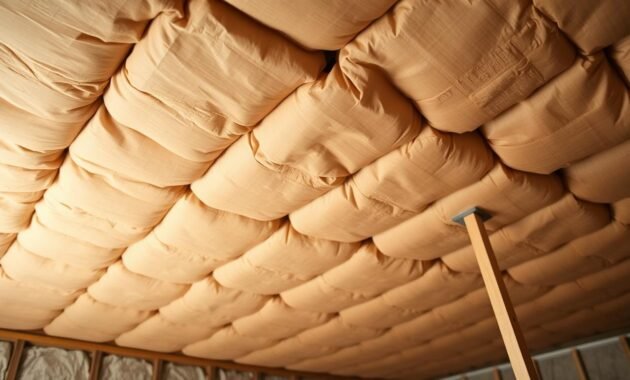
Kraft paper faced insulation batts have their own set of advantages and challenges for basement wall insulation. As a homeowner, knowing these points is key to making a smart choice.
This type of insulation has a built-in vapor barrier. The kraft paper helps control moisture, preventing mold and condensation in your basement ceiling.
- Integrated vapor retarder reduces installation complexity
- Provides additional moisture protection
- Easier to install compared to separate vapor barriers
Yet, faced fiberglass insulation has some downsides. It’s pricier than unfaced options. The paper facing can also make installation tricky, mainly when you need multiple layers or have complex spaces.
When choosing insulation for your basement walls, consider a few things:
- Climate zone requirements
- Moisture levels in your specific basement
- Budget constraints
- Long-term energy efficiency goals
Before picking faced insulation, assess your basement’s needs carefully. While the vapor barrier is helpful, it might not fit every basement insulation project.
Advantages of Using Unfaced Insulation in Basement Ceilings
Unfaced fiberglass batts are great for basement ceiling insulation. They make your home more energy efficient and comfortable. Homeowners find them versatile for improving their basement spaces.
Unfaced insulation is very flexible for basement ceilings. It can be added to existing insulation, improving your home’s thermal performance. This flexibility is a big plus.
Read also: Basement Ceiling Sound Insulation
Moisture Control Strategies
Moisture control is key in basements. Unfaced insulation works well with vapor barriers to fight dampness. It’s better at managing moisture than faced insulation.
Cost-Effectiveness Analysis
| Insulation Type | Initial Cost | Long-Term Savings | Flexibility |
|---|---|---|---|
| Unfaced Fiberglass Batts | Lower | Higher | Excellent |
| Faced Insulation | Higher | Moderate | Limited |
Unfaced insulation is often cheaper upfront. It’s also easy to add to existing insulation, saving money. It’s a smart choice for those watching their budget.
- Easy to install in existing spaces
- Compatible with additional vapor barriers
- Lower material costs
- Adaptable to various basement configurations
Choosing unfaced fiberglass batts for your basement ceiling is wise. It makes your space more energy efficient and moisture resistant. Plus, it’s easy on the wallet.
Professional Installation vs DIY: What You Need to Know
When you start on energy-saving basement renovations, you must decide: go for a pro or do it yourself. Each choice has its own benefits and downsides that affect your project’s outcome.
Choosing a pro means getting more than just someone to do the work. Experts know all about building codes and can handle tricky basement ceilings. They use the right tools and know-how to place insulation correctly, avoiding mistakes that could hurt your home’s energy use.
- Guaranteed precise installation
- Compliance with local building regulations
- Professional-grade equipment usage
- Comprehensive moisture management
Doing it yourself can save money if you’re handy. First, check if you’re okay with technical tasks and have enough time. You’ll need the right tools and know how to insulate properly.
| Installation Method | Cost Range | Skill Level Required | Potential Risks |
|---|---|---|---|
| Professional | $1,500 – $3,500 | Not applicable | Minimal |
| DIY | $500 – $1,200 | Intermediate | Potential installation errors |
Think about your budget, skills, and how complex your project is. If you’re not sure about handling insulation, getting a pro might prevent future problems and save you money.
R-Value Considerations for Basement Ceiling Insulation
Understanding the r-value of basement insulation is key for keeping your home energy-efficient. R-value shows how well insulation stops heat from moving. This is important for your basement ceiling.
Insulation needs vary by climate zone. The right insulation can cut down on energy costs and make your home more comfortable.
Understanding Thermal Resistance
R-value shows how well insulation blocks heat. The higher the R-value, the better it works. For basement ceilings, this means:
- Better temperature control
- Less energy use
- More comfort at home
Recommended R-Values by Climate Zone
Different areas need different R-values for best insulation. Here’s a list of recommended R-values across the U.S.:
| Climate Zone | Recommended R-Value | Typical Insulation Type |
|---|---|---|
| Northern Regions | R-49 to R-60 | Fiberglass or Mineral Wool |
| Central Regions | R-38 to R-49 | Blown-in Cellulose |
| Southern Regions | R-30 to R-38 | Spray Foam |
It’s wise to talk to a local insulation expert for your basement ceiling. They can give advice based on your home and local rules.
Common Installation Mistakes to Avoid
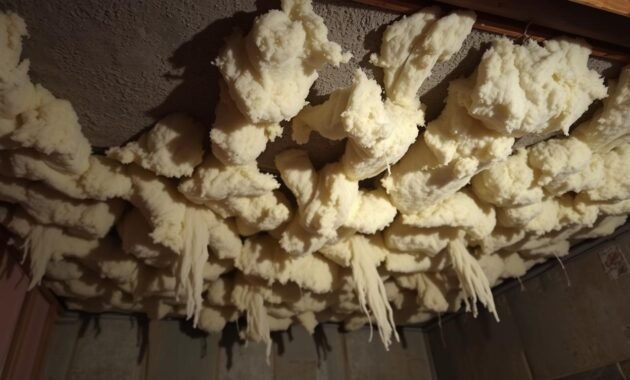
Installing fiberglass insulation for basement ceilings can be tricky. Many homeowners make mistakes that hurt their soundproofing. Knowing these errors can save you time, money, and trouble later.
There are a few big mistakes to watch out for. These mistakes can make your insulation less effective and cause structural problems. Here are the main ones:
- Compressing fiberglass insulation, which reduces its thermal resistance
- Leaving unexpected gaps between insulation panels
- Incorrectly installing vapor barriers
- Neglecting proper air sealing around ceiling edges
- Failing to address moisture control before installation
One big mistake is compressing the insulation. When you squeeze it, it loses its ability to trap air. This makes it less effective at keeping your basement warm or cool.
Getting it right means paying attention to the details. Measure your ceiling space carefully. Cut the insulation to fit without squeezing it. Make sure it covers everything to keep your space comfortable.
Pro tip: If you’re not sure about any part of the process, get help from a pro. A little extra money for expert advice can save you a lot of trouble and make sure your insulation works well.
Moisture Management and Ventilation Requirements
Keeping your basement dry is a big challenge for homeowners. It’s key to manage moisture in basement ceilings to avoid serious problems. Let’s explore the best ways to keep your basement dry and healthy.
Managing moisture in basement ceilings needs a detailed plan. Condensation can quickly become a problem if not tackled early. It’s important to know how moisture forms and use effective prevention methods.
Preventing Condensation Challenges
Condensation happens when warm, humid air meets cool surfaces. In basement ceilings, this can cause mold and wood rot. To fight this, I recommend several steps:
- Install a vapor barrier for basement ceiling to block moisture transmission
- Ensure proper insulation with moisture-resistant materials
- Maintain consistent temperature and humidity levels
- Use dehumidifiers to control ambient moisture
Proper Air Flow Techniques
Ventilation is key in managing moisture. Good air flow stops moisture buildup and lowers mold and mildew risks. Here are some strategies:
- Use exhaust fans to remove humid air
- Install passive vents for continuous air exchange
- Seal any air leaks around windows and pipes
- Consider a whole-house ventilation system for better moisture control
By using these moisture control methods, you’ll make your basement healthier and more comfortable. This will protect your home and your family’s health.
Building Code Requirements and Compliance
Understanding thermal insulation basement requirements can be tricky for homeowners. Local building codes are key to making sure your basement renovation is safe and energy-efficient. These rules change by area, so knowing your local guidelines is vital.
Before starting energy-efficient basement renovations, check with your local building department. Each place has its own set of rules for insulation, how it’s installed, and what materials to use.
- Verify local building code requirements for thermal insulation
- Check fire rating specifications for insulation materials
- Confirm vapor barrier placement regulations
- Understand minimum R-value standards for your climate zone
Important things to keep in mind include:
- Fire resistance ratings for basement ceiling materials
- Proper vapor barrier installation
- Minimum insulation thickness requirements
- Ventilation and air gap specifications
Professional inspectors can ensure your basement insulation project follows local building codes. Not following these rules can lead to expensive fixes or safety hazards. Make sure to research and understand your area’s thermal insulation basement requirements before starting your project.
Conclusion
Exploring basement ceiling insulation has shown me it’s not a simple choice. Your home’s environment, climate, and energy goals are key. They help decide the best insulation for your basement.
Homeowners need to think about moisture, thermal resistance, and how easy it is to install. Basement renovations for energy efficiency need a smart plan. It’s important to assess your basement’s needs before choosing.
Both faced and unfaced insulation have their benefits. The right one depends on local codes, humidity, and climate. Knowing the differences helps make your basement more comfortable and energy-efficient.
Doing your homework or talking to a pro can save you trouble and money. Your basement’s insulation is vital for comfort and energy use. It’s not just a detail.
